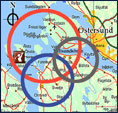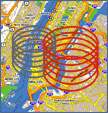

 |
SaTScan™ Software for the spatial, temporal, and space-time scan statistics |  |
|
PurposeSaTScan™ is a free software that analyzes spatial, temporal and space-time data using the spatial, temporal, or space-time scan statistics. It is designed for any of the following interrelated purposes:
The software may also be used for similar problems in other fields such as archaeology, astronomy, botany, criminology, ecology, economics, engineering, forestry, genetics, geography, geology, history, neurology or zoology. Data Types and MethodsSaTScan uses either a Poisson-based model, where the number of events in a geographical area is Poisson-distributed, according to a known underlying population at risk; a Bernoulli model, with 0/1 event data such as cases and controls; a space-time permutation model, using only case data; an ordinal model, for ordered categorical data; an exponential model for survival time data with or without censored variables; or a normal model for other types of continuous data. The data may be either aggregated at the census tract, zip code, county or other geographical level, or there may be unique coordinates for each observation. SaTScan adjusts for the underlying spatial inhomogeneity of a background population. It can also adjust for any number of categorical covariates provided by the user, as well as for temporal trends, known space-time clusters and missing data. It is possible to scan multiple data sets simultaneously to look for clusters that occur in one or more of them. Developers and FundersThe SaTScan™ software was developed by Martin Kulldorff together with Information Management Services Inc. Financial support for SaTScan has been received from the following institutions:
Their financial support is greatly appreciated. The contents of SaTScan are the responsibility of the developer and do not necessarily reflect the official views of the funders. |
|
|
|